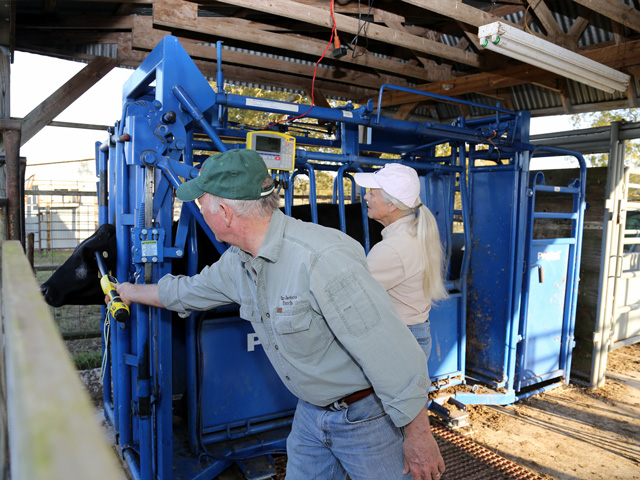Weigh the Options
Pick the Right Livestock Scales to Fit the Business
It's pretty much a proven fact, the average cow-calf producer doesn't do such a great job when it comes to guessing weights on the cow herd. But in these times, when management is intensely focused on saving money and boosting profits, an accurate weight on individual animals is one of the keys to success.
Arnold Nagely, a veterinarian and CEO of Valley Vet Supply, recently outlined the importance of scales in a report to help producers consider how to choose the best equipment to fit their individual operations.
First consider the positives that come from knowing individual weights, he says. These include monitoring rate of gain, which allows producers to more closely watch inputs and track sale day weights; and reducing treatment and vaccination costs by dosing based on accurate weights.
P[L1] D[0x0] M[300x250] OOP[F] ADUNIT[] T[]
In addition, he says accurate weights help producers know they are keeping the best cows in the herd.
"Having this information about each animal helps set production parameters, so producers know which are their best sets of cows," he said. "Our main goal is to make breeding decision that improve the overall genetics of our calf crop. Make sure you are continually keeping back the highest-producing cows. That will improve your herd's genetics for heavier calves down the road."
On the marketing side, Jason Jones with Datamars, reported cases where not being able to closely monitor weight resulted in lower average daily gains on steers a rancher intended to market at 800 pounds. The steers came in under the goal weight by about 8 pounds per head, resulting in a lower take-home than planned by about $545 on each semi-truck load.
In addition, Jones noted it's important to track first-calf heifers to make sure they are at 60 to 65% of their mature weight for that first breeding. This reduces the number of heifers that don't conceive on the first round.
CHOOSING A SET OF SCALES
There is no one-size-fits all system of scales for cattle operators. A complete livestock scale system today typically includes a weigh-scale indicator, a platform, a squeeze chute, load bars and load cell, EID reader and EID ear tags. Jones and Nagely note producers should consider three question before buying scales.
1. Do the scales need to be permanent or portable? An advantage of permanent scales is a load bar is placed under the squeeze chute and bolted to a concrete pad. Jones added, "the more level the load bar is, the more accurate it will be." Choosing a permanent or portable system, will help determine which load bar is best.
2. How will you record animal weights? There is a physical read-out of the weight, which can be hand-written into a record book. But today's more advanced scales work with EID ear tag readers and automatically sync the weights into a digital record-keeping system.
3. How much data do you need? Scales today can do a lot more than weigh animals. Some producers now use scale indicators to capture data on each animal, such as breed, sex, preg check status, or sire/dam information. Producers are able to group animals together based on various characteristics; even program and batch-number vaccinations, with a dosage calculator on some models.
(c) Copyright 2020 DTN, LLC. All rights reserved.






